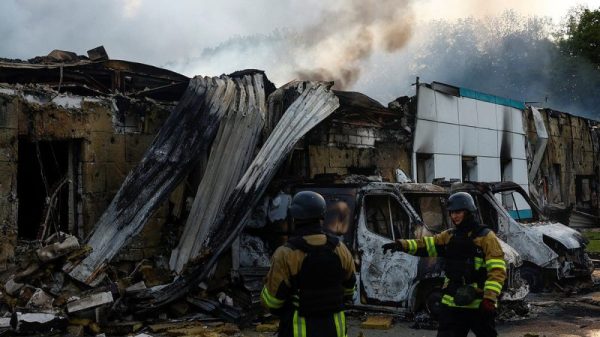Hurricane Idalia is expected to intensify considerably as it heads toward Florida, where officials already have told people to flee, closed schools and shuttered a major airport ahead of a predicted landfall Wednesday along the Gulf Coast.
With powerful winds and life-threatening storm surge, the hurricane is due to hit at Category 3 strength, and millions are under storm warnings, the National Hurricane Center said Tuesday.
FOLLOW LIVE UPDATES
The National Guard is on call and evacuations underway as the storm could deliver a devastating blow to parts of Florida’s Gulf Coast. It is expected to make landfall well north of Tampa, in Florida’s Big Bend region – but a small shift in the track could put the vulnerable population center more at risk.
Before landfall, Idalia could produce a few tornadoes Tuesday along the west central Florida coast and by Tuesday night northward into the Big Bend.
Storm surge – when a storm’s winds push the ocean onshore – could force water to rise up to 12 feet in parts of northern Florida, with “the deepest water … along the immediate coast in areas of onshore winds, where the surge will be accompanied by large and dangerous waves,” the hurricane center warned.
Heavy rain could produce flash flooding Tuesday into Wednesday across portions of the Florida’s west coast and panhandle and southern Georgia, spreading Wednesday into Thursday into portions of the eastern Carolinas. Four to 8 inches of rain could fall from Tuesday to Thursday in those places, flooding streets.
“This is going to be a major hurricane,” Gov. Ron DeSantis said at a Monday news conference.
The storm was churning early Tuesday with maximum winds of 75 miles per hour roughly 370 miles southwest of Tampa, the hurricane center said in a 5 a.m. update.
Track Idalia here >>
As the storm makes its way to Florida, preparations could be seen across the state. Here’s the latest:
• Airports close: Tampa International Airport will suspend all commercial operations beginning Tuesday and stay closed until it can assess any damages later in the week, airport officials announced. The St. Pete-Clearwater International Airport Terminal building will close Tuesday afternoon.
• Evacuations in at least 10 counties: Hillsborough, Franklin, Taylor, Levy, Citrus, Manatee, Pasco, Hernando, Pinellas and Sarasota counties have all called for residents to evacuate certain at-risk areas.
• Schools close: 32 county school districts have issued closures, as have colleges and universities, including Florida State University, the University of Florida and Florida A&M University.
• Emergencies declared: DeSantis expanded an emergency declaration to 46 of 67 Florida counties on Monday morning. Several local jurisdictions have also declared emergencies.
• The Florida National Guard activated: More than 5,000 National Guard members were activated to help respond to the storm.
• US Navy ships begin leaving: Navy ships have begun leaving Florida ahead of Idalia’s landfall, the Navy said Monday.
• Power outages expected: DeSantis told residents to prepare to be without power. “If you are in the path of the storm, you should expect power outages so please prepare for that,” the governor told residents Sunday.
• Hospital system suspending services: Patients will be transferred from at least three hospitals: HCA Florida Pasadena Hospital, HCA Florida Trinity West Hospital and HCA Florida West Tampa Hospital.
“We want everyone to take this storm seriously,” Barbara Tripp, Tampa’s Fire Rescue Chief said during a news conference, adding residents also should clear debris from property and look out for neighbors who may need help.
“Once the wind reaches a certain miles per hour, Tampa Fire Rescue will not be able to respond,” Tripp warned.
With the storm forecast to strengthen quickly as it tracks through the Gulf of Mexico, it’ll be tapping into some of the warmest waters on the planet ahead of making landfall in Florida. If it does, it would join a growing list of devastating storms like monster Hurricane Ian – which leveled coastal Florida and left more than 100 dead – to rapidly intensify before landfall in recent years.
Idalia posed a “notable risk” of this phenomenon, the National Hurricane Center warned Monday, as it travels through the Gulf of Mexico.
Water temperatures around southern Florida climbed to 100 degrees Fahrenheit in some areas this summer, and temperatures in the Gulf overall have been record-warm, with more than enough heat to support rapid strengthening.
Storm surge will be ‘life-threatening’
Deadly storm surge up to 12 feet is possible in Florida’s Big Bend, a danger that only will be worsened by waves fueled by hurricane-force winds stronger than 100 mph. Storm surge accounts for nearly half of all hurricane-related fatalities, the National Oceanic and Atmospheric Administration says, and is the reason behind most storm evacuations.
Cedar Key could be cut off by the high storm surge, National Hurricane Center Deputy Director Jamie Rhome said.
Read more
Track the stormWhat to do and pack ahead of a hurricaneHurricane categories explainedWhat rapid intensification means for hurricanesWhy coastal communities should fear storm surgeHow to read hurricane spaghetti models
“I’m especially concerned for them,” Rhome said during a briefing on Facebook Live. “If you’re watching from Cedar Key, it is imperative that you take this very seriously and if ordered to evacuate, heed those evacuations immediately. The entire island could be completely cut off with conditions like that.”
Evacuation orders along the coast are in place because of the projected storm surge, Rhome stressed.
But it’s not just the coastal areas that could flood. Inland areas that receive evacuees could see hazardous flooding and heavy rainfall from Idalia. Heavy rainfall-related hazards can also occur as far as 100 miles away from where the storm center tracks, warned Andrew Kruczkiewicz, senior researcher at the Columbia University’s Climate School.







































